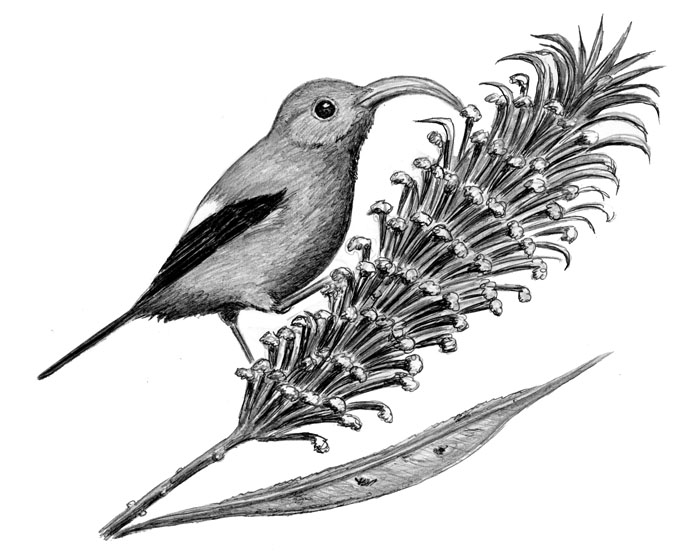
The second trip:
A few weeks ago I wrote about a trip my wife and I took to the Canadian Maritimes. While it was mostly a birding trip (at least it was for me), it was also a 40th wedding anniversary getaway. Since Canada was largely my idea, we decided to take a second trip and this time my wife would choose the destination. I was thinking she might want to take a drive to see the fall foliage in the Adirondacks, or perhaps head south and rent a cabin in the Smokey Mountains. Well, I could not have been more wrong. At the dinner table last night she announced that we should go to Hawaii. I was so flabbergasted by her suggestion that I almost choked on my delicious tofu. “No, not Hawaii,” I whined. I tried to explain that Hawaii is for the middle aged, cruise ship crowd. (Truth be told, we are both past middle age, but she still thinks of it as being old.) As I gave her my list of arguments against her proposal, I glanced over at the refrigerator and saw a magnet that our friend Wendy had given us years ago. On the magnet was a picture of an ‘I‘iwi. That slowed me down. ‘I‘iwi are brilliant red Hawaiian honeycreepers and I’ve never seen one in my life…except on a magnet. (FYI: In case your Hawaiian is a little rusty, ‘I‘iwi is apparently pronounced “ee-ee-vee.”) Seeing a living ‘I‘iwi would be pretty special, but at this point I didn’t know if they still exist. I told my wife that we needed to pause this Hawaiian discussion until I learned a bit more about ‘I‘iwi. Here’s what I found out.
The landmasses that we now know as Nantucket and Martha’s Vineyard were largely formed by glacial activity (Don’t worry, this ties back to Hawaii). Both areas became islands when the enormous Laurentide ice sheet melted 18,000 years ago. Native flora and fauna had little trouble colonizing these new, offshore islands. But things weren’t so easy for Hawaii. Underwater volcanoes formed those islands 2,400 miles from the nearest continent, so no creatures were readily available to inhabit them. But slowly, and mostly by chance, plants and birds stumbled upon the islands. The majority of these birds and plants died out, but a few survived and even reproduced. One family of plants that eventually evolved on the islands is the flowering lobelioids. This brings us to the honeycreepers, birds that adapted to these unique plants. In order to access the nectar found in the tubular flowers, the ‘I‘iwi developed a long, downward curved beak. The crazy hooked beak is the most distinctive feature of the ‘I‘iwi and from a distance the bird looks like it’s eating with a tiny sickle, or one of Freddy Krueger’s fingernails. With this specialized “tool” the ‘I‘iwi had no trouble feeding on the islands’ nectar-rich plants and thus both the birds and the plants thrived for years. Well, they thrived until humans arrived, and then…well, you know.
Because of its location (in the middle of the Pacific Ocean), Hawaii has no native terrestrial mammals, or reptiles or even amphibians, which meant the birds had very few predators or the skills to avoid them. Even the plants never evolved any kind of defenses. They had no discouraging thorns (like roses or cactuses) or nasty bitter flavor (like lima beans). When the early Polynesians arrived on Hawaii they brought pigs, which immediately began eating the vulnerable plants. They also brought dogs (even 1,500 years ago folks couldn’t go on vacation without taking the dog along). The dogs devoured bird eggs, chicks and even the adult birds, some of which were flightless. Things got even uglier when Captain Cook showed up in 1787. He introduced goats, rats and something even more destructive, Europeans. As a result, over fifty of Hawaii’s endemic birds are now extinct, and more are headed in that direction. But what about the bird on the magnet, the ‘I‘iwi? Is it still around? Right now the answer to that question is yes, but its’ future looks bad. Isn’t this a cheery topic? Don’t worry, it gets worse.
The remaining ‘I‘iwi are typically found in Hawaii’s mountainous areas, usually above 5,000 feet. The cool mountain habitat provides the birds with protection from deadly mosquitoes. Avian malaria, which is tranmitted by mosuitoes, affects birds all over the world, but it’s only fatal in areas where it has been newly introduced (i.e., Hawaii). Many of the ‘I‘iwi that once lived in lower elevations have already succumbed to the illness. But the colder air has prevented the disease-carrying mosquitoes from breeding in the mountains…or at least it used to. Climate change has warmed even those locations, making the last few birds vulnerable. The news isn’t totally bleak, however. Sterilized mosquitoes are now being released in an effort to curb the mosquitoes’ population, and so far this program has shown promise. (Don’t ask me how they sterilize the mosquitoes, but I think it has something to do with making them wear tight underwear.)
After reading about ‘I‘iwi, plus other Hawaiian specialties, including (and I swear these names are real) `Oma`o, `Apapane, `Amakihi,`Elepaio, I decided my wife’s idea was a good one after all. We are headed to Hawaii. With any luck I’ll see an ‘I‘iwi, and maybe a few of those other birds, too. If I get lucky, I’ll let you know. In the meantime, I have to go pack my Hawaiian bird books, my binoculars, and my not-so-tight underwear. I also have to somehow figure out how to pronounce `Oma`o, `Apapane, `Amakihi and `Elepaio. And above all, make sure I use “lei” properly.